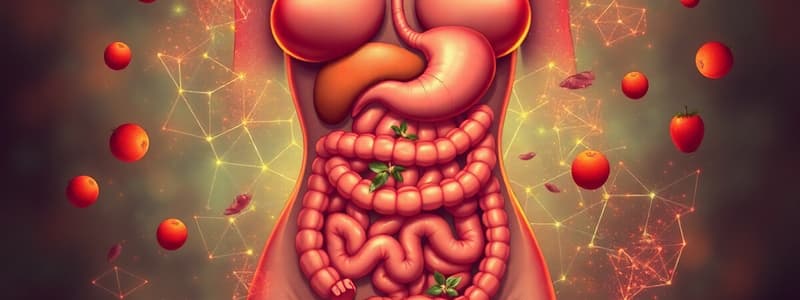Podcast
Questions and Answers
What characterizes Bulimia Nervosa?
What characterizes Bulimia Nervosa?
- Consuming large amounts of healthy food
- Restricting food intake to dangerous levels
- Avoiding food entirely for long periods
- Episodes of excessive eating followed by purging (correct)
Anorexia Nervosa involves consuming an excessive amount of food without control.
Anorexia Nervosa involves consuming an excessive amount of food without control.
False (B)
What are the two main categories of malnutrition?
What are the two main categories of malnutrition?
Undernutrition and overnutrition
The __________ is the organ responsible for breaking down food after it enters the digestive system.
The __________ is the organ responsible for breaking down food after it enters the digestive system.
Match the eating disorders with their descriptions:
Match the eating disorders with their descriptions:
Which organ is responsible for the initial breakdown of food through salivary enzymes?
Which organ is responsible for the initial breakdown of food through salivary enzymes?
The esophagus is responsible for the chemical digestion of food.
The esophagus is responsible for the chemical digestion of food.
What is the primary function of the stomach in the digestive system?
What is the primary function of the stomach in the digestive system?
The primarily responsible part of the digestive system for nutrient absorption is the ______.
The primarily responsible part of the digestive system for nutrient absorption is the ______.
Which of the following processes does not occur in the mouth?
Which of the following processes does not occur in the mouth?
Match the organ with its function in the digestive system:
Match the organ with its function in the digestive system:
Anorexia Nervosa is an eating disorder characterized by excessive eating.
Anorexia Nervosa is an eating disorder characterized by excessive eating.
What is Bulimia Nervosa?
What is Bulimia Nervosa?
Which digestive enzyme is responsible for breaking down starch into less complex sugars?
Which digestive enzyme is responsible for breaking down starch into less complex sugars?
The process of egestion refers to the absorption of digested food into the bloodstream.
The process of egestion refers to the absorption of digested food into the bloodstream.
What is the role of intestinal enzymes in the digestion process?
What is the role of intestinal enzymes in the digestion process?
Lipase, related to fats, converts them into __________ and __________.
Lipase, related to fats, converts them into __________ and __________.
Match the digestive enzymes with their respective substrates:
Match the digestive enzymes with their respective substrates:
Which part of the digestive system is primarily responsible for absorption of nutrients?
Which part of the digestive system is primarily responsible for absorption of nutrients?
Anorexia Nervosa is characterized by overeating and a lack of control over one's eating habits.
Anorexia Nervosa is characterized by overeating and a lack of control over one's eating habits.
What is the main function of enzymes in the digestive process?
What is the main function of enzymes in the digestive process?
____________ helps digestion by breaking down proteins in the stomach.
____________ helps digestion by breaking down proteins in the stomach.
Which digestive enzyme is produced by the pancreas?
Which digestive enzyme is produced by the pancreas?
Flashcards
Malnutrition
Malnutrition
A condition resulting from not getting sufficient nutrients or consuming too many nutrients.
Undernutrition
Undernutrition
A form of malnutrition where an individual does not consume enough calories or nutrients.
Overnutrition
Overnutrition
A form of malnutrition where an individual consumes excessive nutrients, often leading to obesity.
Anorexia Nervosa
Anorexia Nervosa
Signup and view all the flashcards
Bulimia Nervosa
Bulimia Nervosa
Signup and view all the flashcards
Digestion
Digestion
Signup and view all the flashcards
Digestive System
Digestive System
Signup and view all the flashcards
Mechanical Digestion
Mechanical Digestion
Signup and view all the flashcards
Chemical Digestion
Chemical Digestion
Signup and view all the flashcards
Mouth
Mouth
Signup and view all the flashcards
Esophagus
Esophagus
Signup and view all the flashcards
Stomach
Stomach
Signup and view all the flashcards
Intestines
Intestines
Signup and view all the flashcards
Digestive Enzymes
Digestive Enzymes
Signup and view all the flashcards
Ptyalin
Ptyalin
Signup and view all the flashcards
Pepsin
Pepsin
Signup and view all the flashcards
Pancreatic Amylase
Pancreatic Amylase
Signup and view all the flashcards
Trypsin
Trypsin
Signup and view all the flashcards
Lipase
Lipase
Signup and view all the flashcards
Absorption
Absorption
Signup and view all the flashcards
Villi
Villi
Signup and view all the flashcards
Assimilation
Assimilation
Signup and view all the flashcards
Study Notes
Digestive System Overview
- The digestive system is a group of organs that work together to break down food into nutrients and absorb them into the body.
- Digestion involves both mechanical and chemical processes. Mechanical digestion physically breaks down food, while chemical digestion uses enzymes to break down food into smaller molecules.
Digestive Processes
- Ingestion: The process of taking food into the body.
- Absorption: The process by which nutrients are absorbed into the bloodstream.
- Assimilation: The process by which the absorbed nutrients are used by the body's cells for growth and energy.
- Egestion: The process of eliminating undigested food from the body.
Major Organs
- Mouth: Digestion begins here with the chewing of food; salivary enzymes start breaking down carbohydrates.
- Esophagus: Transports food from the mouth to the stomach.
- Stomach: Temporarily stores food and mixes it with chemicals that help break it down into smaller, more digestible forms.
- Small Intestine: Breaks down food further and absorbs nutrients and minerals.
- Large Intestine: Absorbs water and salt from undigested foods and turns waste into stool.
- Anus: The terminal opening from which fecal material is expelled.
Accessory Organs
- Liver: Produces bile that helps digest fats; filters out toxins.
- Gallbladder: Stores bile from the liver and releases it into the small intestine.
- Pancreas: Produces enzymes to digest fats, carbohydrates, and proteins; regulates blood sugar.
Digestive Enzymes
- Enzymes speed up chemical reactions that break down large food molecules into smaller molecules that are easier to absorb.
- Different enzymes work on different components of food.
- Mouth: Ptyalin (salivary amylase), Mucin
- Stomach: Pepsin
- Pancreas: Pancreatic amylase, Trypsin, Chymotrypsin, Lipase, Lactase, Maltase, and Sucrase
- Intestine: Peptidase, and Lipase
Digestive System Diseases
- Diarrhea: Excessive water secretion by the large intestine.
- Constipation: Slow peristalsis in the colon, resulting in hard, dry stools.
- Hepatitis: Inflammation of the liver, caused by alcohol or viral infections.
- Gallstones: Crystals formed from cholesterol, bile salts, and calcium in the gallbladder.
- Peptic Ulcer: Painful sores in the stomach or small intestine.
- Hemorrhoids: Swollen veins in the rectum or anus.
- Appendicitis: Inflammation of the appendix.
Nutritional Requirements and Disorders
- Malnutrition: Disorders related to improper or insufficient diet, including undernutrition (not enough calories), overnutrition (too many calories), and micronutrient deficiencies.
- Eating Disorders: Anorexia nervosa (restricting food/drinks), Bulimia nervosa (episodes of excessive eating followed by purging).
Time Food Stays in Digestive Organs
- Mouth: 5-30 seconds
- Esophagus: 7-10 seconds
- Stomach: 2-24 hours
- Small Intestine: 3-5 hours
- Large Intestine: 18 hours to 2 days
Studying That Suits You
Use AI to generate personalized quizzes and flashcards to suit your learning preferences.



